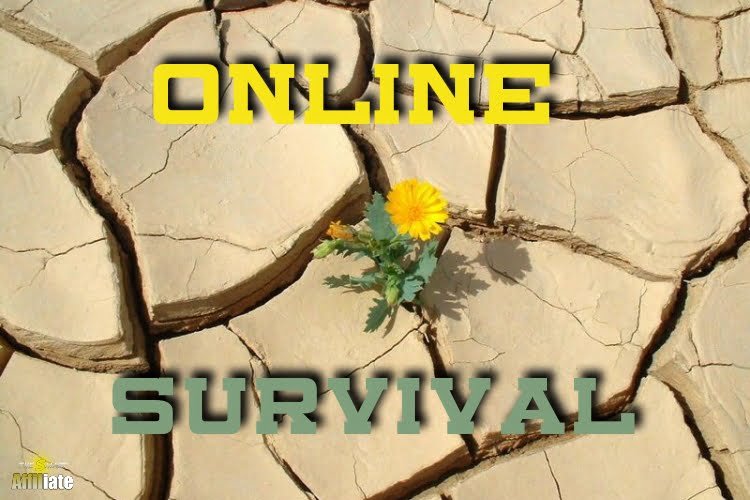Surviving Online
For today’s Marketing Monday, I take a look at 3 survival tactics for affiliate marketers. They are no big secret, but do make a difference when put to use.
Most affiliate marketers are always looking for a successful market that will produce the biggest paycheck. Sadly though, they also think there is some magic formula that’s readily available to help them achieve it.
In reality, it’s more complicated than that. What it actually boils down to is just using good marketing practices that have been proven over years of hard work and dedication. What?
I know that for some this is hard to wrap your head around. However, these tactics have been proven to work with online marketing and continues to work today.
With these top three marketing tips, you’ll increase sales and survive using affiliate marketing online.
What are these three tactics?
Create at least a unique web page for each product you are promoting separately.
Do not lump all the products together on one page like an eCommerce site just to save some time or space on developing each page. In fact, it even works better to have a mini-site for each product with it’s own domain name focused on just that one product and nothing more.
When doing it, make sure to include product reviews on the website so visitors will have an initial idea on what the product can do for those who buys that product.
Also whenever possible, include testimonials from users who have already tried the product. Just make sure that these customers are willing to allow you to use their names and photos on your site of the specific product you are marketing.
You can also write separate articles that highlighting the uses of the product and include them on your website as an additional page for each article. Be sure to make each page attractive, compelling and include calls of action within the information (something I miss doing from time to time).
Write each headline that will attract the readers to want to read more, even contact you. Highlight your special points. This will help your readers to learn what the page is about and will want to find out more.
Offer free reports to your readers.
Whenever possible position the offer at the very top side of your page so it simply cannot be missed. Include something catchy that says more than, “Hey! Get my free report!”
Also, you will want to create and load autoresponder messages ready to go. This is so that each one will be mailed on a schedule to those who enter their personal information into your sign up box.
Why is this important? According to research, an actual sale is realized usually on the seventh contact with a prospect.
Only two things can possibly happen when someone visits a web page: they either act on the information given, or the prospect leaves the page never to return again.
By signing them up, you can then place useful information into their inboxes at certain specified times. You can then remind them of the product they thought about getting later and will eventually make a sale.
Be sure that the content is directed toward specific reasons to buy the product. Do not make it sound like a sales pitch or desperate plea to buy from you.
Focus on the important points like how this product can make their life easier and more enjoyable. Include compelling subject lines in the email. Ones that would make you want to open it if it arrived in your email inbox.
As much as possible, avoid using the word “FREE!” in the email. This is because there are still older spam filters that will flag that type of content and move it into the junk before anyone can even read them.
Convince those who signed up for your free reports that they will be missing out on something big if they don’t get your promoted products and services.
Drive traffic that is specifically targeted to your product.
Just think, if the person who visited your site has no interest whatsoever in what you have to offer, they will quickly leave and move on never to return again. Also this will negatively impact your bounce rate!
You can write and submit articles for publication in ezines and e-reports. This way you can select publications that is focused in on your target customers. What you get published might just grab their interest enough to visit your site. Over time, the more article you submit and have published, the more targeted traffic you will get.
Make a commitment to write at least two articles every week, with a minimum of at least 500-600 words per article. By continuously writing and maintaining these articles over time, you can eventually generate as much as a hundred targeted readers to your site each day.
Also remember that usually only 1 out of every 100 targeted visitors are likely to buy your product or get your services. If you can generate as much as 1,000 targeted hits for your website each day, that means you should make at least 10 sales based on those average statistics.
Final Thoughts
The tactics I covered above are not really all that difficult to do, if you think about it. It just requires some time, a bit of effort and an action plan on your part.
I encourage you to use these tips for several affiliate marketing programs to see if they work for you. You just might find that they will work and help you maintain a good source of income online and help you survive in this business that not all marketers can do.
I would like to hear from you to know what you think, questions you might have, or share techniques that have worked for you! 🙂


You have some good points Michel. But I do get a bit confused about mini sites. I cannot see where they would get much SEO juice in light of the fact the content becomes limited and perhaps static over time. Not that sales pages get much anyway.
So, are you saying to buy a separate domain for each product you promote? Could you not do something similar by creating a page for each product under public_html?
I am so much more comfortable with working with e-commerce sites! Although people keep saying it is not hard to set up your sales page, I struggle with the concept.
Creating separate pages (like in WordPress) for each product works fine, even though they are static, as long as they are relevant. If you chain several pages to a main page, that works better. Example would be have a main review page on product, another page on how you used product that refers back to review page, and even create another page about how others have had success with product that refers back to review page. Each page would rank separately, but two pages are used to refer back to review page and help build authority for that page.
Now, when it comes to mini-sites, each one can be setup similar to a sales page as though you are promoting your own product. With it’s own domain name related to the product will help it to rank higher in the search engines, but only for a time. The idea here is to setup separate sites with a particular main keyword in mind and concentrate the mini-site to that keyword. If you have say 5 main keywords, you could setup 5 mini-site focusing just on a keyword for each one. This way you have a greater chance for ranking each site higher because it is using the power of a domain name along with a tightly focused keyword. PBNs (private blogging networks) build upon this idea.
The idea behind this method is actually SEO based to generate traffic from search engine sources. As we are all aware, there are other ways just as effective for generating targeted traffic than just SEO. 😉
Hi Michel, questions. So a mini site is a site that focus only n solely on the said product. Everything on this site revolves aroubd this particular product n is usually static, as compare to a full site like say your this blog. Am I right?? 🙂
As for ‘Grab my free report’ strategy. I heard it’s no longer attractive as before. A more attractive strategy seems to be gearing towards giving away a ‘training course’ kind of approach. What’s your thought on this? Cheers!
A mini-site is narrow and highly focused site on just one or a few products. You can think of them like a affiliate version of a sales page combined with reviews. The tactic is to help rank higher in the search engines while concentrating on promoting that product.
When it comes to free reports -it depends upon what niche you are talking about. If you are attempting to compete with say, make money online – then a free report (even a training course or coaching session isn’t enough) if you are not well known! Otherwise something like , free report on instant hemorrhoid relief still works very well! Hope that helps! 🙂
Thanks Michel 🙂
Your are most welcome, Sandy! 🙂